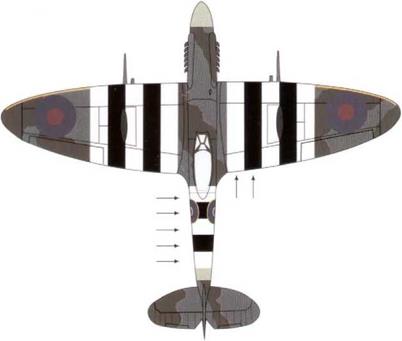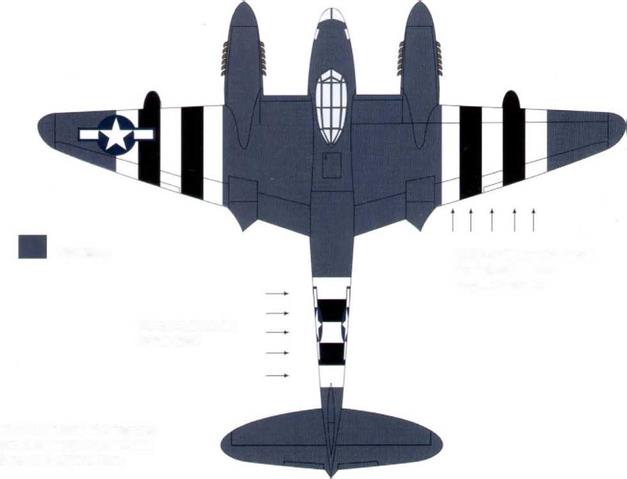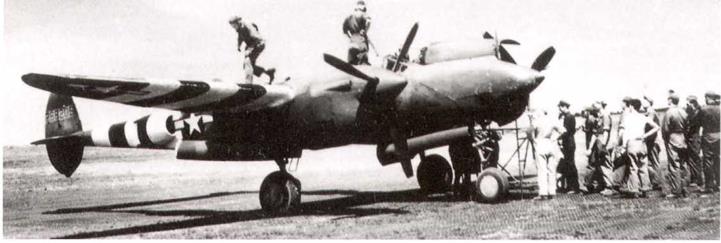Supreme Headquarters Allied Expeditionary Force issues Top Secret memo whose subject was “Distinctive Marking – Aircraft”, dated April 18, 1944 (the “Invasion Stripes”)
On April 13, 1944, the newly formed Supreme Headquarters Allied Expeditionary Force issued a draft of a major Operation Memorandum, Number 23, entitled “DISTINCTIVE MARKING – AIRCRAFT”. This was approved very quickly and issued on April 18, 1944. Only 100 copies of the Top Secret document were made; 55 were issued to the necessary commands, each bearing its own number. The other 45 copies were held as spares. The following information comes from copy number 36, issued to the Chief Administrative Officer (this was declassified by DOD on October 12,1966, at the request of the author).
TOP SECRET TOP SECRET
SUPREME HEADQUARTERS COPY No.38
ALLIED EXPEDITIONARY FORCE
OPERATION MEMORANDUM ) 18 April, 1944
NUMBER 23 )
DISTINCTIVE MARKING – AIRCRAFT
1. OBJECT
The object of this memorandum is to prescribe the distinctive markings which will be applied to US and BRITISH aircraft in order to make them more easily identified as friendly by ground and naval forces and by other friendly aircraft.
2. SCOPE
a. The instructions contained herein will apply to the following types of US and BRITISH aircraft; (I) Fighters and fighter – bombers. (2) Tactical and photographic reconnaissance aircraft. (3) Aircraft employed in spotting for naval gunfire and field artillery. (4) Light bombers. (5) Medium bombers. (6) Troop carrier aircraft, including four engine types. (7) Glider tugs, including four engine types. (8) Liaison aircraft and Air OP’s employed in forward areas for fire spotting and adjustment or for advanced aircraft control. (9) Coastal Command, Air Sea Rescue and disembarked Fleet Air Arm aircraft except seaplanes and four engine aircraft which need not be marked.
b. These instructions will not apply to the following classes of aircraft:(l) Four engine bombers. (2) Air transports. (3) Gliders. (4) Night fighters. (5) Seaplanes.
3. GENERAL
a. The instructions contained herein will be effective on the day of the assault and thereafter until it is deemed advisable to change. Aircraft will be given distinctive markings as shortly before the day of the assault as it is possible in order to protect the effectiveness of their use.
b. These instructions are in no way intended to change the present US and BRITISH national markings now in use, namely: the USAAF white star on a white horizontal bar; and the RAF red, white and blue roundel.
4. DISTINCTIVE MARKINGS
a Single engine aircraft. (It Upper and lower wing surfaces of aircraft listed in paragraph 2 a above, will be painted with five white and black stripes, each eighteen inches wide, parallel to the longitudinal axis of the airplane, arranged in order from center outward; white, black, white, black, white. Stripes will end six inches inboard of the national markings. (2) Fuselages will be painted with five parallel white and black stripes, each eighteen inches wide, completely around the fuselage, with the outside edge of the rearmost band eighteen inches from the leading edge of the tailplane.
b. Twin engine aircraft. (I) Upper and lower wing surfaces of aircraft listed in paragraph 2 a above, will be painted from the engine nacelles outward with five white and black stripes, each twenty-four inches wide, arranged in order from center outward: white, black, white, black, white. (2) Fuselages will be painted with five parallel white and black stripes, each twenty-four inches wide, completely around the fuselage, with the outside edge of the rearmost band eighteen inches from the leading edge of the tailplane.
c. Four engine troop carrier aircraft and glider tugs. (I) Same as for twin-engine aircraft, wing stripes to be outboard of the outer engine nacelles.
d. Stripes will in no case be painted over the national markings, which take precedence. Wing stripes will extend from leading edge to trailing edge of wings. Special equipment, such as deicer boots, will not be painted over.
e. Types of paint to be employed: (1) USAAF Units – as directed by the Commanding General of the Air Force concerned. (2) RAF Units – as directed by the appropriate BRITISH agency.
f. At Appendix ‘A’ are sample sketches of aircraft painted according to these instructions.
5. BRIEFING
Army, Navy and Air Commanders will disseminate complete information concerning these distinctive markings to all troops under their commands no earlier before the day of the assault than will insure the complete distribution of the information.
By command of General Eisenhower:
W. B. Smith
Lieutenant General, U. S. Army,
OFFICIAL: Chief of Staff.
H. R. BULL,
Major General, G. S.C.,
Assistant Chief of Staff, G-3.
|
COPY NO. |
DISTRIBUTION |
|
Allied Naval Commander, Expeditionary Force, |
1-3 |
|
Command-in-Chief, 21 Army Group, |
4-8 |
|
Commanding General, First US Army Group, |
9-10 |
|
Air Commander-in-Chicf, AEAF, |
11-16 |
|
The Secretary, The Admiralty, |
17 |
|
The Under Secretary of State, The War Office (MO 3) |
18 |
|
Commanding General, ETOUSA |
19 |
|
Commander-in-Chief, Home Forces, |
20 |
|
The Under Secretary of State, The Air Ministry |
21-23 |
|
Commanding General, USSTAF, |
24 |
|
Air Officer Commanding, Bomber Command |
25 |
|
Chief of Combined Operations, |
26 |
|
The Secretary, Chiefs of Staff Committee, Offices of the War Cabinet, |
27 |
|
The Secretary, Combined Chiefs of Staff, Washington, D. C. |
28 |
|
OPD, War Department, Washington, D. C. |
29 |
|
OPD, Navy Department, Washington, D. C. |
30 |
|
A. F.H. Q. |
31 |
|
Supreme Commander, SFLAEF, |
32 |
|
Deputy Supreme Commander, |
33 |
|
Chief of Staff, |
34 |
|
Deputy Chief of Staff, |
35 |
|
Chief Administrative Officer, |
36 |
|
Adjutant General, |
37 |
|
Secretary General Staff, |
38 |
|
AC of S, G-l, |
39 |
|
AC of S, G-2 |
40-41 |
|
AC of S, G-3 |
42-47 |
|
AC of S, G-4, |
48-50 |
|
AC of S, G-5, |
51 |
|
Chief Engineer, |
52 |
|
Chief Signal Officer, |
53 |
|
Public Relations Division, |
54 |
|
Headquarters Commandant, |
55 |
|
Spares TOP SECRET |
56-100 |
|
|
|
|
|
|
|
|
|
|
|
|
|
|
|
|
|
|
|
![]()
![]()
![]()


![]()
|
Lockheed F-5B-1-LO, 42-68205, shows off the new invasion markings at Poltava, Russia, on June 21,1944. It was part of the first shuttle force to attack Germany, then continued on to Russia. Unfortunately, the force had been followed by a Luftwaffe Heinkel He 177, and that night, the Germans launched a devastating raid, destroying many of the B-17s. (USAF) |
First Army Commander requests change to narrower stripes (“Invasion Stripes”) for Field Artillery and Liaison Aircraft, May 1944.
The First Army Commander, Lieut. Gen Omar Bradley, on May 16, 1944, requested authority to modify distinctive markings for Field Artillery and Liaison (CUB) aircraft. Modification requested was to use 8 inch stripes instead of 18 inch stripes, it was not considered that this change would jeopardize the safety of these small aircraft through identification failure by friendly Air and Ground Forces. Reason for the request was the excessive weight added by paint and the increased difficulty in concealing such aircraft in forward combat areas. This request was approved the next day.











